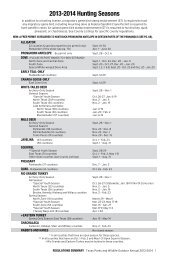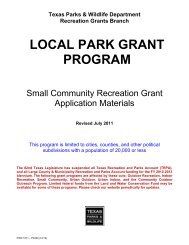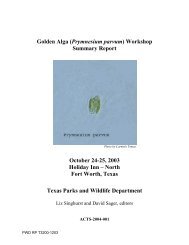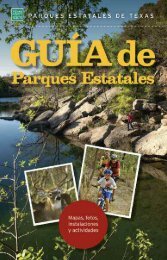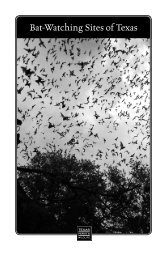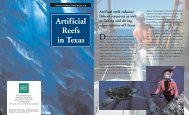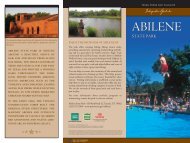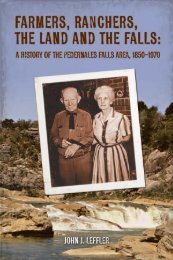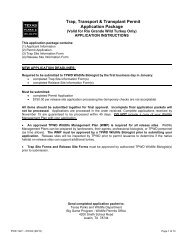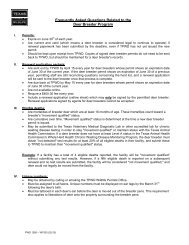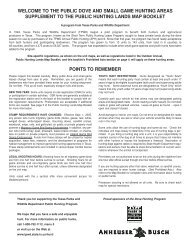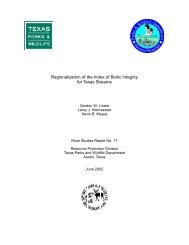Chapter 57. FISHERIES - Texas Parks & Wildlife Department
Chapter 57. FISHERIES - Texas Parks & Wildlife Department
Chapter 57. FISHERIES - Texas Parks & Wildlife Department
You also want an ePaper? Increase the reach of your titles
YUMPU automatically turns print PDFs into web optimized ePapers that Google loves.
management actions that Florida had successfully implemented to prevent scarring<br />
(Sargent et al. 1995, Ehringer and Anderson 2002, Stowers et al. 2002). Florida has<br />
enacted mandatory measures to prevent propeller scarring of seagrasses in its bays and<br />
estuaries.<br />
TPWD created the RBSSA by rule in 2000 to study seagrass resources and protect them<br />
from the effects of boat propellers. The rule TPWD adopted for the RBSSA in 2000<br />
focused on education and voluntary compliance as the principal means of protecting<br />
seagrass resources. Unfortunately, despite extensive and costly efforts by TPWD over the<br />
past five years, the voluntary approach proved ineffective.<br />
The proposed amendment to §<strong>57.</strong>921 consisted of two different, but complementary,<br />
regulatory approaches to conserve seagrasses within the RBSSA. Of the two, only one<br />
was adopted during the November 3, 2005 meeting of the <strong>Texas</strong> <strong>Parks</strong> and <strong>Wildlife</strong><br />
Commission. The approach that was adopted (proposed §<strong>57.</strong>921(d) - (e)) prohibits the<br />
uprooting of seagrasses throughout the entire area of the RBSSA by submerged<br />
propellers, and defines "seagrass plant" to include the five species prevalent within the<br />
RBSSA. Further, the rule as adopted clarifies that it is not a violation to operate an<br />
electric trolling motor or anchor a vessel within the RBSSA. The rule as adopted also<br />
expands the list of purposes for which signs may be placed in RBSSA to include signs<br />
that mark special zones within the area. The rule as adopted prohibits the uprooting or<br />
digging out of seagrasses by submerged propeller except as allowed under a GLO coastal<br />
lease, or as may result from: (1) using an electric trolling motor, (2) anchoring a vessel<br />
within the area, or (3) other activities permitted under state law. The prohibition would<br />
apply throughout the entire RBSSA (32,144 acres) starting May 1, 2006.<br />
In summary, TPWD in 2000, after extensive research into the issues surrounding seagrass<br />
resources in <strong>Texas</strong>, complied with the "Seagrass Conservation Plan in <strong>Texas</strong>" by<br />
establishing the RBSSA and using a voluntary approach to the protection of seagrass in<br />
the area. Through observation of boaters in the area from TPWD staff it was determined<br />
that the voluntary prop-up areas (zones) were not effective in getting boaters to change<br />
their behavior. Additionally, bottom scarring is still very visible in the area. The lack of<br />
compliance and the inability to see improvement in the area in regards to bottom scarring<br />
led the department to consider other options to protect seagrass in the area. This led to the<br />
adoption of the current rule which prohibits seagrass uprooting in the RBSSA.<br />
Literature Cited<br />
Brown-Peterson, N. J., M. S. Peterson, D. L. Nielson, M. D. Murphy, R. G. Taylor, and J.<br />
R. Warren. 2002. Reproductive biology of female spotted seatrout in the Gulf of Mexico:<br />
differences among estuaries? Environmental Biology of Fishes 63:405-415.<br />
Ehringer, J. N., J. Anderson. 2002. Seagrass Transplanting and Restoration in Tampa<br />
Bay. pages 39-46 in H.S. Greening, ed. Seagrass Management: It's Not Just Nutrients!<br />
2000 Aug 22-24; St. Petersburg, FL. Tampa Bay Estuary Program. 246 p.



